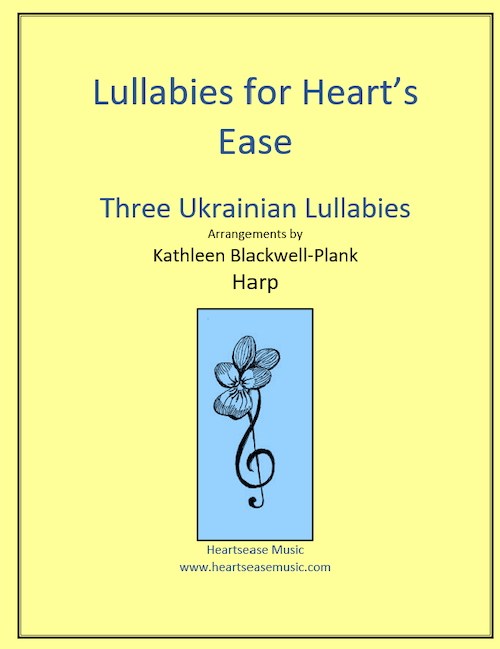


Many of us recall lullabies fondly throughout our lives. They calm and comfort us and they evoke emotions of feeling safe and secure. They also pass down cultural knowledge and are shared by multiple generations as Kathleen Blackwell-Plank points out in the foreword to her new collection, Lullabies for Heart’s Ease. These three Ukrainian lullabies are dedicated to the people of Ukraine, and the music is available through her website, heartseasemusic.com.
The first lullaby is “Gray Cat” (Kotyku Sirenkyi) in G minor. English lyrics are published at the end of the piece. They share the story of the lullaby, but they were probably not meant to fit the notes if you wanted to sing along. The simple, plaintive melody is presented multiple times with slight changes to the accompaniment or ornamentation to the melody line. The arranger uses harmonics and changes octaves, and chord symbols are included above the staff for those who want to improvise.
The typesetting is easy to read although the layout is just a little funky. The final measure of only one note takes up an entire line when it could easily have fit on the previous line.
The next selection is “Sleep, Jesus, Sleep” (Spy, Isuse, Spy) in D minor. No lyrics are provided for this one, but the story is described in the foreword. Multiple verses are varied with changes of octaves, thirds below the melody, and a couple of harmonics.
The final piece is “The Dream Passes by the Window” (Oy Khodyt Son Kolo Vikon) in E minor. Once again, English lyrics are provided at the end, but Ukrainian lyrics are also printed within the body of the music. The time signature alternates frequently between 6/8 and 3/4. Like the other two lullabies, most of the variation between verses is by changing octaves or adding some harmonics.
On her YouTube channel, Blackwell-Plank explains that George Gershwin was smitten with this lullaby when he heard it performed by the Ukrainian National Chorus in 1929—so much so that the opening motif of “Summertime” is similar to the beginning of this lullaby.
All of these pieces can be heard on Blackwell-Plank’s YouTube channel. No fingering is suggested on any of these lullabies, but most of the notes fall comfortably and logically in the hands. There are no pedal or lever changes on any of the pieces. Upper beginners and lower intermediate level players should be able to play this music.
This is a lovely collection, and, in the arranger’s own words, this music offers “the opportunity to travel the world and experience the beauty of lullabies.”
Emily Linlo (a.k.a. The Knitting Harpist) has published “River Lullaby” from the Disney film, Prince of Egypt through Sheet Music Plus. This five-page arrangement is for pedal harp.
There are frequent pedal changes, and all are notated below the staff except for one written in the middle of the staff. Linlo also provides pedal charts each time there is a key change.
The arrangement begins simply with a single note melody played as harmonics. Then, the left hand adds an arpeggiated pattern for accompaniment below the single note right hand melody (sans harmonics). After the first key change, the left hand accompaniment changes to octaves alternating with chords. The right hand plays a section featuring the melody as the top note of descending sixteenth notes. There is one more key change before the final verse which is much less busy: the right hand plays chords below the melody while the left hand plays mostly large rolled chords such as tenths.
This is a very captivating melody written by Hans Zimmer and Stephen Schwartz. Linlo’s arrangement offers variety among the several verses presented. There are no fingering suggestions. Some sections are more technically challenging as are some of the pedal changes, so this would be more suitable for an intermediate or higher level player. You can hear Linlo playing it on YouTube. Check out the video and see if you like it.
This last selection, while not a lullaby, falls into the soothing category and deserves mentioning. Jolene Stucky has written and published an original tune to accompany “Celtic Psalm 23” with altered lyrics by Isaac Watts. The altered lyrics are printed at the end. There are no accidentals making it equally accessible for both pedal and lever harp players.
This is a simple, fairly short, and catchy melody in an AABA format. It is in 6/8 in the key of D major. No fingering is suggested. The single note right hand melody is accompanied by intervals of fifths, sevenths, and some eighth note patterns. The final phrase is repeated an octave higher at the very end to draw the piece to a conclusion. The typesetting is easy to read and it is just two pages in length. Intermediate players should be able to sightread the music, and beginners can master it with a little practice.
This pretty piece would be useful in a variety of settings including church services and weddings. It is available through Harp Column Music where you can also hear an electronic version. •






